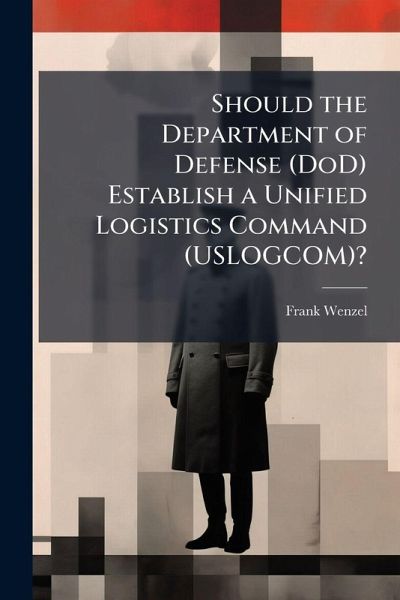
Should the Department of Defense (DoD) Establish a Unified Logistics Command (USLOGCOM)?
Versandkostenfrei!
Versandfertig in über 4 Wochen
15,99 €
inkl. MwSt.
Weitere Ausgaben:

PAYBACK Punkte
8 °P sammeln!
This monograph asserts that DoD should establish a Unified Combatant Command (COCOM)-level USLOGCOM. DoD should begin a deliberate 10-20 year process to establish a USLOGCOM. As an intermediate and immediate step, DoD should make the Defense Logistics Agency (DLA) an operational subordinate command of U.S. Transportation Command (USTRANSCOM). The monograph also makes additional recommendations that work toward an eventual USLOGCOM, including returning the Defense Contract Management Agency to DLA control and placing additional feeding and fueling functions in theater under DLA's control. The m...
This monograph asserts that DoD should establish a Unified Combatant Command (COCOM)-level USLOGCOM. DoD should begin a deliberate 10-20 year process to establish a USLOGCOM. As an intermediate and immediate step, DoD should make the Defense Logistics Agency (DLA) an operational subordinate command of U.S. Transportation Command (USTRANSCOM). The monograph also makes additional recommendations that work toward an eventual USLOGCOM, including returning the Defense Contract Management Agency to DLA control and placing additional feeding and fueling functions in theater under DLA's control. The monograph relies on the large volume of existing work to arrive at the above recommendation. There is a clear majority of work calling for increased centralization of strategic logistics authorities. These previous studies were done by a wide variety of respected organizations including the Government Accountability Office, the Defense Science Board (DSB), the RAND Corporation, and monographs by graduate students. The DSB points out that recommendations for consolidation are consistent with their 1996, 1998, and 2001 studies on logistics transformation. The report pointedly asks, since these recommendations and the recommendations of other groups are consistent and not new, "Why has none of this been done before?" In an attempt to answer this question, they offer four possible explanations. First, stakeholders have felt no compelling reason (similar to a profit and loss statement in the private sector) to change to a more efficient organizational construct. Second, driven by risk avoidance and diffusion of authority in the logistics systems, decision times are too long. Third, the system is designed to focus on resource allocations principally to the Services rather than to mission priorities. Finally, the report states there is little incentive to use effective metrics to monitor resource utilization and then there is little, if any, consequence for not meeting or even setting This work has been selected by scholars as being culturally important, and is part of the knowledge base of civilization as we know it. This work was reproduced from the original artifact, and remains as true to the original work as possible. Therefore, you will see the original copyright references, library stamps (as most of these works have been housed in our most important libraries around the world), and other notations in the work. This work is in the public domain in the United States of America, and possibly other nations. Within the United States, you may freely copy and distribute this work, as no entity (individual or corporate) has a copyright on the body of the work. As a reproduction of a historical artifact, this work may contain missing or blurred pages, poor pictures, errant marks, etc. Scholars believe, and we concur, that this work is important enough to be preserved, reproduced, and made generally available to the public. We appreciate your support of the preservation process, and thank you for being an important part of keeping this knowledge alive and relevant.












